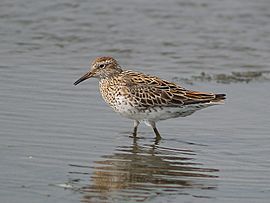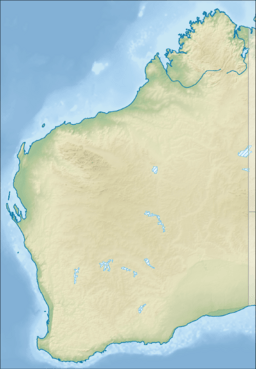Lake McLarty facts for kids
Quick facts for kids Lake McLarty |
|
|---|---|

The lake is an important site for sharp-tailed sandpipers
|
|
| Location | South West, Western Australia |
| Coordinates | 32°42′19″S 115°42′50″E / 32.70528°S 115.71389°E |
| Type | Freshwater |
| Basin countries | Australia |
| Designation | Lake McLarty Nature Reserve; Peel-Yalgorup System Ramsar site |
| Max. length | 2.1 km (1.3 mi) |
| Max. width | 1.25 km (0.78 mi) |
Lake McLarty is a freshwater lake and nature reserve in Western Australia. It covers about 219-hectare (540-acre) (hectares). The lake is named after the McLarty family, who were early settlers in the area during the 1860s.
Lake McLarty is located about 90 kilometres (56 mi) south of Perth. It sits on the eastern side of the Harvey Estuary. This lake is part of a larger area called the Peel-Yalgorup System. This system is a special Ramsar site, which means it's an important wetland protected by an international agreement. Lake McLarty is well-known for birdwatching, especially for waders, also known as shorebirds.
About Lake McLarty
Lake McLarty has an oval shape and is quite shallow. Its bottom slopes gently. The largest open water area is about 2.1 kilometres (1.3 mi) from north to south and 1.25 kilometres (0.78 mi) from east to west.
The lake is in a natural dip in the coastal land. A ridge of old sand dunes separates it from the Harvey Estuary. This ridge, covered in plants, is about 600 metres (2,000 ft) wide.
Plants and Animals
Lake McLarty is home to many different kinds of plants and animals. It's a great place to see nature.
Plants of the Lake
Around 30 types of plants have been found at Lake McLarty. Along the northern and eastern edges, you can see groups of trees like banbar and swamp paperbark. Below these trees, there are patches of broadleaf cumbungi.
The southwestern part of the lake area is mostly pasture (grassland). The middle part of the western shore has open eucalypt woodland. Here, you might find tuarts, flooded gums, and swamp peppermints. These trees have a grassy layer underneath them.
Other plants found here include spearwood, golden-wreath wattle, Swan River peppermint, and sheoaks. Six types of orchids have also been seen in the reserve. These include the pink fairy and cowslip orchids.
Birds of the Lake
The muddy areas around Lake McLarty are very important for migratory waders. These birds travel long distances to feed here.
About 163 hectares (400 acres) of the reserve is known as an Important Bird Area (IBA) by BirdLife International. This means it's a globally important place for birds. The lake regularly supports more than 1% of the world's population of several bird species. These include red-necked stints, sharp-tailed sandpipers, white-headed stilts, red-necked avocets, and red-capped plovers. Sometimes, many blue-billed ducks can also be found here.


